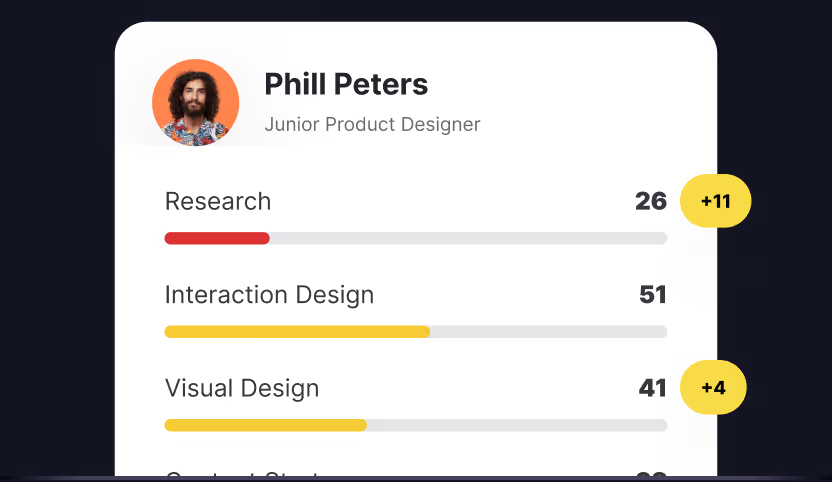
Getting detailed insights into a designer's skill set — beyond what they can show in a resume or portfolio — has long been a challenge for hiring managers, team leads, and even designers themselves. Quantifying design skills was nearly impossible, and comparing one designer's skill set to another's was time-consuming if it was even possible. This is why Uxcel has released Skill Graph 2.0 — a new, more detailed way to figure out where a designer's strengths really lie.
Skill Graphs have been part of the Uxcel profile for a while. But there were limitations to how they were created. The biggest was that there was only a limited set of data points available for each designer because the Verified Designer skill test only included 40 questions from a pool of hundreds. And because of the nature of how questions were included in the test, not every designer would be tested on every skill. That could leave big gaps in how a designer's skill set was displayed and didn't always give the most accurate picture.
Skill Graph 2.0 solves this issue with 6 themed Skill Assessments around key areas of designer knowledge. These assessments assure that designers are tested on the skills that matter most in each of those key areas.
Skill Graph 2.0 Advantages
Skill Graphs give anyone looking at a designer's Uxcel profile an immediate, visual indication of where that designer's skills are strongest. This is critical when making hiring decisions, as you need to know that the designer you're considering has the skills your company and current team need most. It's also incredibly useful for team leads who are trying to figure out where the gaps are among their team members, and whether it's better to enroll their team in UX design training or hire a new team member to fill those gaps.
We've spent months researching which skills are vital to becoming an expert designer. Some basic skills were obvious right away — things like typography, color theory, principles of UX, and principles of design. But we wanted to go deeper than that to create a well-rounded picture of what it means to be a design expert. We finally landed on 6 categories of skills that the best designers possess, including soft skills.
The Skill Graph 2.0 Skill Assessments cover 6 main categories: UX Research, Visual Design, Interaction Design, Content Strategy, Leadership, and Core Qualities. The Skill Graph shows how strong a designer is in each of these areas, creating a full picture of what a designer has to offer.
Improved Skill Assessments
Skill Assessments give a solid picture of each designer's strengths and areas for improvement. Each Skill Graph area was chosen based on the qualities and expertise that are necessary for a successful career as a UX designer, from entry-level designers to team leads.
UX Research
This is a vital skill for any UX designer, as it enables them to figure out what users actually want and how to best meet those needs. Take the UX designer assessment test to verify your knowledge of the topics like general UX research, qualitative and quantitative data, and user testing.
Visual Design
The goal of visual design is to use typography, icons, illustrations, colors, layout, and UI as a whole to create delightful, meaningful, and accessible interfaces.
Interaction Design
How a design looks is only one part of the equation for a successful product. How the design works is equally as important, and interaction design comes into play here.
Content Strategy
A design without a solid content strategy isn't particularly useful to users. A thorough understanding of information architecture, UX writing, content branding, and content design is essential for UX designers.
Leadership
While not every designer aspires to be a team lead, understanding the leadership qualities of your existing team and potential hires is key to creating a well-rounded team. It also gives a clear picture of who might be best to step into a leadership role.
Core Qualities
In addition to a mastery of design skills, UX designers need to have a variety of soft skills, including creative thinking, communication, collaboration, and remote work skills.
Uxcel's Skill Graph allows designers to see concise benchmarks against other designers around the world by role and years of experience. It also allows designers (and design teams) to see where they have room for improvement, complete with learning recommendations.
For designers looking to get hired, the Skill Graph provides insights to recruiters on where their strengths lie and what type of role they'd be best suited for. And it gives those designers an idea of where they could strengthen their skills to get better opportunities.
Team leads and educators can see where their team members have room for improvement, as well as where their team members' strengths lie. This is an invaluable resource for teams who need to know exactly which skills they need to bolster, or where new hires might be appropriate.




